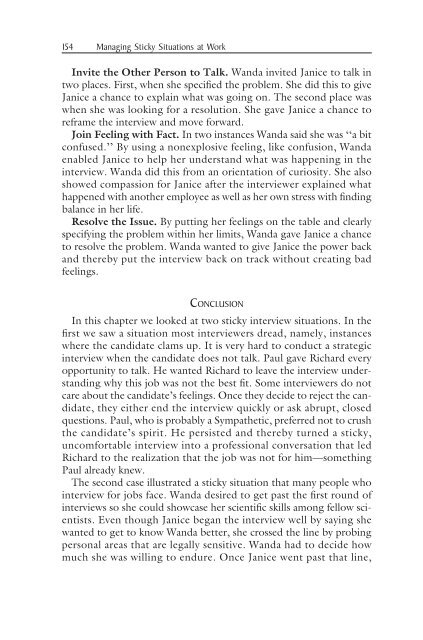Managing Sticky Situations at Work
Managing Sticky Situations at Work
Managing Sticky Situations at Work
You also want an ePaper? Increase the reach of your titles
YUMPU automatically turns print PDFs into web optimized ePapers that Google loves.
154 <strong>Managing</strong> <strong>Sticky</strong> <strong>Situ<strong>at</strong>ions</strong> <strong>at</strong> <strong>Work</strong>Invite the Other Person to Talk. Wanda invited Janice to talk intwo places. First, when she specified the problem. She did this to giveJanice a chance to explain wh<strong>at</strong> was going on. The second place waswhen she was looking for a resolution. She gave Janice a chance toreframe the interview and move forward.Join Feeling with Fact. In two instances Wanda said she was ‘‘a bitconfused.’’ By using a nonexplosive feeling, like confusion, Wandaenabled Janice to help her understand wh<strong>at</strong> was happening in theinterview. Wanda did this from an orient<strong>at</strong>ion of curiosity. She alsoshowed compassion for Janice after the interviewer explained wh<strong>at</strong>happened with another employee as well as her own stress with findingbalance in her life.Resolve the Issue. By putting her feelings on the table and clearlyspecifying the problem within her limits, Wanda gave Janice a chanceto resolve the problem. Wanda wanted to give Janice the power backand thereby put the interview back on track without cre<strong>at</strong>ing badfeelings.CONCLUSIONIn this chapter we looked <strong>at</strong> two sticky interview situ<strong>at</strong>ions. In thefirst we saw a situ<strong>at</strong>ion most interviewers dread, namely, instanceswhere the candid<strong>at</strong>e clams up. It is very hard to conduct a str<strong>at</strong>egicinterview when the candid<strong>at</strong>e does not talk. Paul gave Richard everyopportunity to talk. He wanted Richard to leave the interview understandingwhy this job was not the best fit. Some interviewers do notcare about the candid<strong>at</strong>e’s feelings. Once they decide to reject the candid<strong>at</strong>e,they either end the interview quickly or ask abrupt, closedquestions. Paul, who is probably a Symp<strong>at</strong>hetic, preferred not to crushthe candid<strong>at</strong>e’s spirit. He persisted and thereby turned a sticky,uncomfortable interview into a professional convers<strong>at</strong>ion th<strong>at</strong> ledRichard to the realiz<strong>at</strong>ion th<strong>at</strong> the job was not for him—somethingPaul already knew.The second case illustr<strong>at</strong>ed a sticky situ<strong>at</strong>ion th<strong>at</strong> many people whointerview for jobs face. Wanda desired to get past the first round ofinterviews so she could showcase her scientific skills among fellow scientists.Even though Janice began the interview well by saying shewanted to get to know Wanda better, she crossed the line by probingpersonal areas th<strong>at</strong> are legally sensitive. Wanda had to decide howmuch she was willing to endure. Once Janice went past th<strong>at</strong> line,















